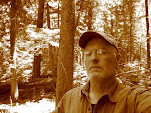It was a gray fall day, the clouds a smear with touches of orange from the sun filtering through. The tide was still up although it had been dropping for an hour or so. I put in and cross the small channel and immediately flush a Harrier from an unseen spot. It flies away low across the spartina.
With a late start I the trip was not intended to be too long and I set out to explore some channels that I had not been in, or at least didn't remember being in. I am usually quite keen on finding and remembering landmarks, but big marshes put that skill to the test, a test that I fail often enough. I tried to find the long diagonal. I remember it because for a couple of seasons it had a good Swan nest at about the midpoint. Sometimes swamp channels shift and close off. I've seen that in fresh water marshes where cattails can form floating islands. Salt water spartina seems to be more stable, at least according to the old maps. Anyway, I can't find the east side entrance. I head to the upriver end.There are two openings in the upper end. I know the west one well. So, I head into the east one and it takes me at an angle back to my put-in.
When I set out into the big marsh the wind was light, but now it has freshened up a good 10mph or more. As I head towards Milford Point, it reaches whistling speed - when the wind running over my ears is whistling. It's a tough grind. Three separate flocks of Canada Geese get up as I grind. The first two are about 120 birds each, and the third about 75. The winds is really pushing and I turn back about a quarter mile from the point.




